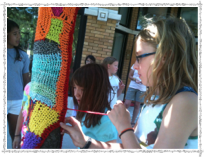


Megarhyssa atrata laying her egg on the horntail wasp larva – – – Photo by Cheryl Osgood The ovipositor actually consists of three tubes, two of which serve as a sheath that houses the drilling tube and helps to guide it and and protect it when not in use. The membranes of her lower abdomen twist into a disc and a special fluid is secreted that helps to dissolve the woody material as the ovipositor works its way down in the tree tissue, honing in on the horntail wasp larva. Then the wasp inserts the tip of its prodigious ovipositor precisely at right angles to the tree surface and begins to drill a hole down into the tree. The female ichneumon wasp constantly taps the surface of the tree bark with its attennae, until it detects some combination of odor and/or sound that signals the presence of a horntail wasp grub in a cavity deep in the wood of the tree. Ichneumon means “tracker” in Greek, and it’s an apt description for these predatory wasps, which use their long antennae to locate the larva of another wasp, the horntail wasp, Tremex Columba, several inches deep in the tissue of dead trees like the maple next to us. Megarhyssa atrata beginning to drill hole in tree – – – Photo by Cheryl Osgood I managed a couple of so-so photos, but Grasshopper recorded the entire sequence of what turned out to be the unique egg-laying process of the Giant Ichneumon Wasp, Megarhyssa atrata. The light was too dim for natural light photography, and Grasshopper quickly began shooting a sequence of photos with her macro lens and flash while I juggled with the flash settings on my Nikon camera unfortunately I had not brought the ringlight I prefer for insect photography. The insect was braced with its legs against the tree trunk, looking like a miniature black and yellow drilling rig. Perched on the bark was an extraordinary creature, a large black wasp, almost two inches long, with a yellow head and legs, a large abdomen, and an incredibly long “tail”, more than three inches long. We were working near the base of a dead maple, which had a variety of bird’s nest fungi, jelly fungi, and other mushroom species growing on it, when Grasshopper let out an excited “Oh my God!” and pointed to a section of the disintegrating bark of the tree a few feet up from the ground. Giant Ichneumon Wasp, Megarhyssa Macrurus - Photo by Cheryl Osgood


 0 kommentar(er)
0 kommentar(er)
